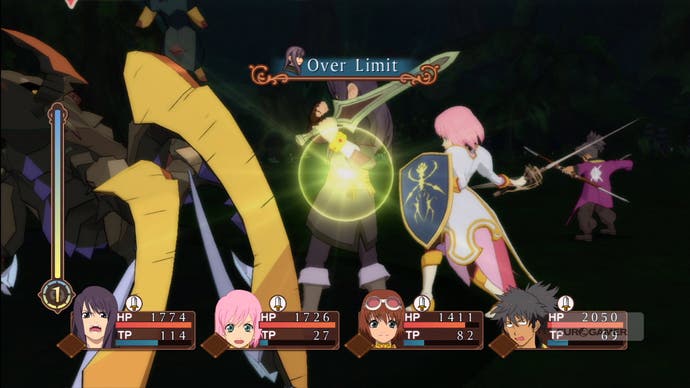Tales of Vesperia
Yuri update?
Crucially, you'll need to block regularly, an action which halves the damage you take from an enemy strike and, while the system is not without its clumsiness, the to-and-fro patter ensures fights are engaging. Later in the game you gain access to an overlimit, triggered by filling a gauge through both taking and dealing damage, which allows a character to attack incessantly for a short amount of time. These long chains of attack are both fun to execute and watch. Fights are graded on factors such as the amount of damage taken, the amount of TP remaining at the end of the battle, your effectiveness at blocking, and so on, and the emphasis is always on perfecting techniques for better rewards.
As new artes unlock naturally during play (as well as being learned from special weapons), extending the length of potential combos, there's enough of a long-term reward structure to keep things interesting. The system really blossoms during boss fights, where the freedom that comes from 360-degree movement around a battlefield facilitates positional tactics. It's kind of thing that action games have been doing far better for years but, still, the integration of these systems into a JRPG is uncommon and the experience is all the richer for it.
Elsewhere, Namco takes the mid-budget graphical approach, approximating a cel-shaded look (faked through the clever use of shaders) that falls just short of the quality of Eternal Sonata's similar aesthetic. Without motion capture, the character animations are stiff and awkward, and the pregnant pauses in cut-scene camera cuts are only just rescued by the quality of the voice acting.

Nevertheless, the game's wonder is in its incessant supply of micro challenges and diversions: the Fable II style character titles that you're encouraged to collect; the poker games on Nam Cobanda; the perks that smooth progression in a similar way to LEGO Star Wars' red bricks; the encyclopedia of monsters whose pages you must fill by scanning every enemy you encounter; the item synthesis challenges; the cookery mini-game and nine legendary (and optional) Giganto monsters provide the game's biggest challenge as well as its most rewarding achievement.
There's no denying that Tales of Vesperia lacks the big-budget feel of a Final Fantasy or Dragon Quest, or that its innovations are designed only to pique the interest of erstwhile genre fans, not to inspire genre converts. But Namco is to be applauded for updating the series with no small amount of consideration and flair, an effort that has resulted in the strongest entry to the aging series yet, and one which makes up for its lack of polish with an abundance of detail, character and, dare I say it, soul.
Tales of Vesperia is due out for Xbox 360 in June. It came out in the US last August.









